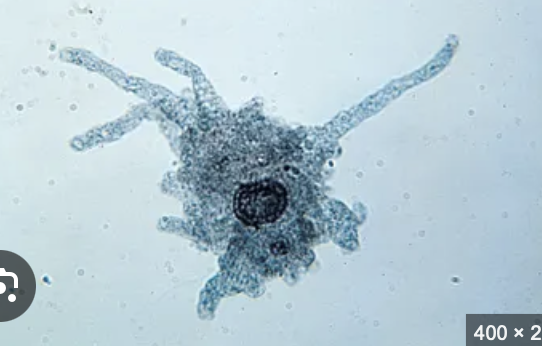Ch: 27- The Diversification of Life - Protists
1/61
There's no tags or description
Looks like no tags are added yet.
Name | Mastery | Learn | Test | Matching | Spaced |
|---|
No study sessions yet.
62 Terms
What are protists in the classification system?
The “junk drawer”
protists are a
paraphyletic group
paraphyletic group
includes some but not all descendants of a common ancestor
monophyletic group
ancestor + all its descendants
Are protists monophyletic?
No because the group excludes
Is there any single synapomorphy that unites all protists?
No
Are eukaryotes monophyletic?
Yes
synapomorphies of eukaryotes
nuclear envelope
mitosis and meiosis
mitochondrial respiration
cytoskeleton
ecological impact of protists
Phytoplankton (protists) are major producers in aquatic ecosystems
human health impact of protists
many protists are parasitic
evolutionary significance of protists
earliest eukaryotes; innovations such as
nucleus
mitochondria
meiosis
multicellularity
molecular phylogenies
help classify organisms with few visible traits
eukaryotic lineages
Unikonta
Bikonta
Unikonta
cells with one or no flagella
Bikonta
cells with two flagella
Unikonta protists
Amoebozoa, Opisthokonta
Bikonta protists
Alveolata, Stramenopila, Rhizaria, Plantae, Excavata
Major Protists Groups
Excavata
Rhizaria
Alveolata
Stramenopila
Amoebozoa
Excavata
Protist group with
ventral feeding groove
two nuclei
lost or modified mitochondria (disc-like cristae).
Diplomonads
Excavates with
two nuclei
modified mitochondria (mitoses)
many are parasitic
Euglenids
Photosynthesis
free living protists
invest food particles through cytosome
disc-like cristae
Rhizaria
Protist Group characterized by
long, slender pseudopodia
shells (tests) made of calcium carbonate
Group defined by sac-like alveoli under the plasma membrane; may have cilia or flagella.
specialized reticulopdia
branching pseudopods that trap food

Foraminifera
Rhizarian protists with
calcium carbonate shells
specialized reticulopdia: branching pseudopods that form food traps
Alveolata
Protists group defined by
sac-like alveoli under the plasma membrane
may have cilia or flagella
Ciliates
Protists that use cilia for locomotion and feeding; common in aquatic environments
Ciliates example
Paramecium
Dinoglagellates
Protists with
two flagella
test made of cellulose
many are photosynthetic with red/brown pigments
Can cause red tides and bioluminescence
produces saxitoxin
Saxitoxin
A toxin produced by some dinoflagellates; blocks sodium channels and can be fatal
Apicomplexa
Parasitic alveolates with an apical complex that allows penetration of host cells
Apicomplexa example
Plasmodium (causes Malaria)
Stramenopila
Group with
hair-like projections on flagella
includes photosynthetic and fungus-like organisms.
Oomycetes (Water Molds)
Fungus-like stramenopiles that absorb nutrients; not true fungi (convergent evolution)
Diatoms
Photosynthetic stramenopiles with silicon dioxide shells; contribute to diatomaceous earth used in filters and abrasives.
Diatomaceous Earth
Deposits of fossilized diatoms; used as filters, pesticides, abrasives, and absorbents.
Brown Algae
Multicellular, photosynthetic stramenopiles containing fucoxanthin pigment; includes kelp.
used as commercial thickening product
Kelp Structure
Holdfast (root), stipe (stem), blades (leaves); not true plant organs.
Amoebozoa
Protists that feed by engulfing prey (phagocytosis) and move with lobe-like pseudopodia (lobopods).
Lobose Amoebae
Free-living amoebas using pseudopodia for movement and feeding.
Cellular slime molds
Amoebozoans that are unicellular until stressed; form multicellular reproductive structures; display altruistic behavior (stalk dies to help reproduction).
Plasmodial slime molds
Amoebozoans capable of problem-solving and spatial memory; can find the shortest route to food sources.
Ingestive feeding
Protists that consume particles or cells directly; includes ciliated and pseudopodia-based feeders
Phagocytosis
Engulfing prey using pseudopodia; common in amoebas.
Absorptive feeding
Protists that absorb nutrients directly across membranes
Saprolegnia
An oomycete that absorbs nutrients from dead organic matter (cotton mold)
Photosynthetic Feeding
Protists that produce energy using chloroplasts and light; may have pigments like chlorophylls or xanthophylls
Primary Endosymbiosis
A eukaryotic cell engulfed a photosynthetic bacterium (cyanobacterium) that became a chloroplast; occurs in ancestral Plantae.
Chloroplasts have two membranes
Evidence for Primary Endosymbiosis
Chloroplast DNA resembles cyanobacteria
Endosymbiotic cyanobacteria live in some protists/animals today
Glaucophyte algae chloroplasts have peptidoglycan layer
Secondary Endosymbiosis
A eukaryotic cell engulfed a photosynthetic eukaryote (alga); the engulfed cell became a chloroplast with four membranes.
Occurred multiple times independently (convergent evolution).
Protists with 2 chloroplast membranes
Plantae
red algae
green algae
Protists with 4 chloroplast membranes
Rhizaria - Chlorachniophytes
Excavate - Euglenids
Alveolata - Dinoflagellates
Stramenopila - Diatoms, Brown Algae
Amoeboid Movement
Movement by cytoplasmic streaming through pseudopodia.
flagellar movement
Few, long flagella; slower undulating motion
ciliary movement
Many short cilia; fast, rotational movement
Asexual reproduction
Occurs by binary fission; produces genetically identical offspring.
Sexual Reproduction
Involves meiosis; protists were the first organisms to evolve sexual reproduction
nuclear envelope origin
Formed from plasma membrane infoldings; allowed separation of transcription and translation.
Mitochondria origin
Formed through endosymbiosis between an anaerobic eukaryote and aerobic bacterium
Endosymbiotic Theory (Mitochondria)
An ancestral eukaryote engulfed an aerobic bacterium, which became the mitochondrion
evidence for endosymbiotic theory
Mitochondria have their own genome
DNA resembles proteobacteria
Mitochondria generate ATP for host cell
Support and Protection Structures
Diatoms → silicon dioxide shells
Dinoflagellates → cellulose plates
Foraminifera → calcium carbonate shells
Multicellularity
Evolved independently in some protists (e.g., brown algae, slime molds).